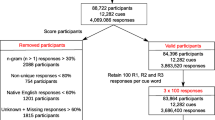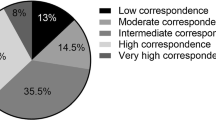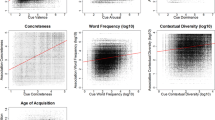Abstract
Word activation has caused ample investigations in many different scientific areas. Various theories have long been debated in predicting and interpreting the fundamental language phenomenon. From a perspective of mechanics, this study considers the word activations as imaginary forces and quantifies their amount by adapting the formula of the universal gravitation to the corresponding imaginary masses and distance that are estimated via the statistics of language experience. In large scale experiments, we found that the word activation forces not only straightforwardly predict various kinds of word activations, but also lead to a simple and human-comparably accurate measure to identify word closest associates including synonyms, near-synonyms, antonyms and similar functional words. The plausibility of identified closest associates with over 10,000 popular English words is highly inspiring.
Similar content being viewed by others
References
Balota D. A., Lorch R. F. (1986) Depth of automatic spreading activation: Mediated priming effects in pronunciation but not in lexical decision. Journal of Experimental Psychology. Learning, Memory, and Cognition 12: 336–345
McKoon G., Ratcliff R. (1992) Spreading activation versus compound cue accounts of priming: Mediated priming revisited. Journal of Experimental Psychology. Learning, Memory, and Cognition 18: 1155–1172
Church K., Hanks P. (1990) Word association norms, mutual information, and lexicography. Computational Linguistics 16: 22–29
Will, L., & McDonald, S. (2000). The direct route: Mediated priming in semantic space. In Proceedings of the 22nd Annual Conference of the Cognitive Science Society (pp. 675–680).
Will, L. (2001). Towards a theory of semantic space. In Proceedings of the 23rd Annual Conference of the Cognitive Science Society (pp. 576–581).
Lund K., Burgess C. (1996) Producing high-dimensional semantic spaces from lexical co-occurrence. Behavior Research MIC 28: 203–208
Padó S., Lapata M. (2007) Dependency-based construction of semantic space models. Computational Linguistics 33: 161–199
Erk, K., & Padó, S. (2008). A structured vector space model for word meaning in context. In Proceedings of the annual meeting of the ACL (pp. 897–906).
Salton G. et al (1975) A vector space model for automatic indexing. Communications of the ACM 18: 613–620
Lin, D. (1998). Automatic retrieval and clustering of similar words. In Proceedings of the annual meeting of the ACL (pp. 768–774).
Hinrich S. (1998) Automatic word sense discrimination. Computational Linguistics 24: 97–124
McCarthy, D., et al. (2004). Finding predominant word senses in untagged text. In Proceedings of the 42th annual meeting of the ACL (pp. 280–287).
Livesay, K., & Burgess, C. (1997). Mediated priming in high-dimensional meaning space: What is “mediated” in mediated priming? In Proceedings of the 19th Annual Conference of the Cognitive Science Society (pp. 436–441).
Livesay, K., & Burgess, C. (1998). Mediated priming does not rely on weak semantic relatedness or local co-occurrence. In Proceedings of the 20th Annual Conference of the Cognitive Science Society (pp. 609–614).
Kutas M., Hillyard S. A. (1984) Brain potentials during reading reflect word expectancy and semantic association. Nature 307: 161–163
Henson R. et al (2000) Neuroimaging evidence for dissociable forms of repetition priming. Science 287: 1269–1272
Crinion J. et al (2006) Language control in the bilingual brain. Science 312: 1537–1540
Gennari S. P. et al (2007) Seidenberg, context-dependent interpretation of words: Evidence for interactive neural processes. NeuroImage 35: 1278–1286
Hoeks J. C. J. et al (2004) Seeing words in context: The interaction of lexical and sentence level information during reading. Cognitive Brain Research 19: 59–73
Mitchell T.M. et al (2008) Predicting human brain activity associated with the meanings of nouns Science 320: 1191–1195
Mitchell, T. M., et al. (2008). Predicting human brain activity associated with the meanings of 295 nous. Science, 320 (Supporting Online Materials).
Seidenberg M. S. (1997) Language acquisition and use: Learning and applying probabilistic constraints. Science 275: 1599–1603
Seidenberg M. S. et al (2002) Does grammar start where statistics stop. Science 298: 553–554
Introduction to the corpus is available at http://www.natcorp.ox.ac.uk/.
Jun, G., Hanliang, G., & Zhanyi, W. (2011). An activation force-based affinity measure for analyzing complex networks. Nature online magazine: Scientific Reports, 2011. http://www.nature.com/srep/2011/111012/srep00113/full/srep00113.html.
Rubenstein H., Goodenough J. B. (1965) Contextual correlates of synonymy. Communications of the ACM 8: 627–633
Aziz-Zadeh L. et al (2006) Congruent embodied representations for visually presented actions and linguistic phrases describing actions. Current Biology 16: 1818–1823
Boulenger V. et al (2006) Cross-talk between language processes and overt motor behavior in the first 200 ms of processing. Journal of Cognitive Neuroscience 18(10): 1607–1615
Pulvermüller F. et al (1996) Brain rhythms of language: Nouns versus verbs. European Journal of Neuroscience 8: 937–941
Neininger B., Pulvermüller F. (2003) Word-category specific deficits after lesions in the right hemisphere. Neuropsychology 41: 53–70
Haxby J. V. et al (2001) Distributed and overlapping representations of faces and objects in ventral temporal cortex. Science 293: 2425–2430
Polyn S. M. et al (2005) Category-specific cortical activity precedes retrieval during memory search. Science 310: 1963–1966
Author information
Authors and Affiliations
Corresponding author
Rights and permissions
About this article
Cite this article
Guo, J., Chen, G. & Xu, W. Word Activation Forces: Distinctive Statistics Revealing Word Associations. Wireless Pers Commun 66, 511–521 (2012). https://doi.org/10.1007/s11277-012-0740-1
Published:
Issue Date:
DOI: https://doi.org/10.1007/s11277-012-0740-1




